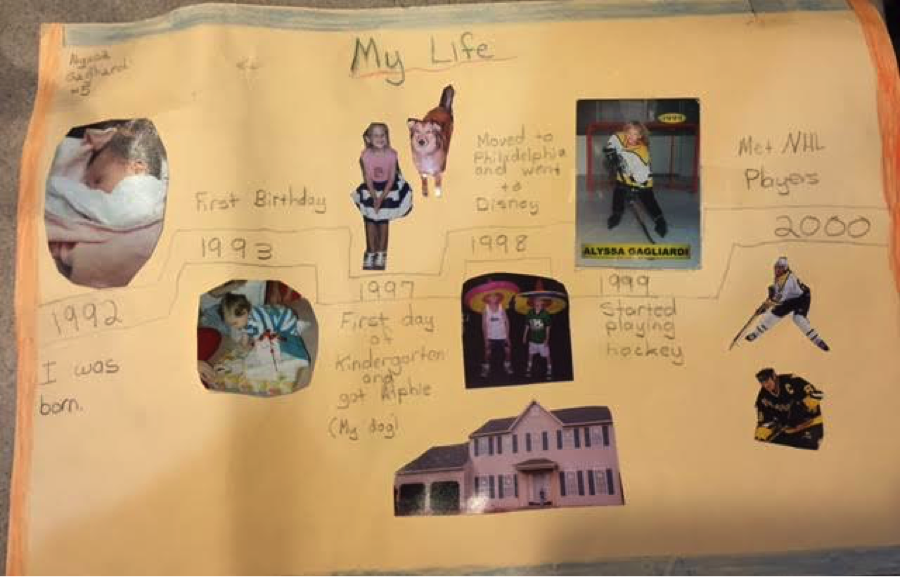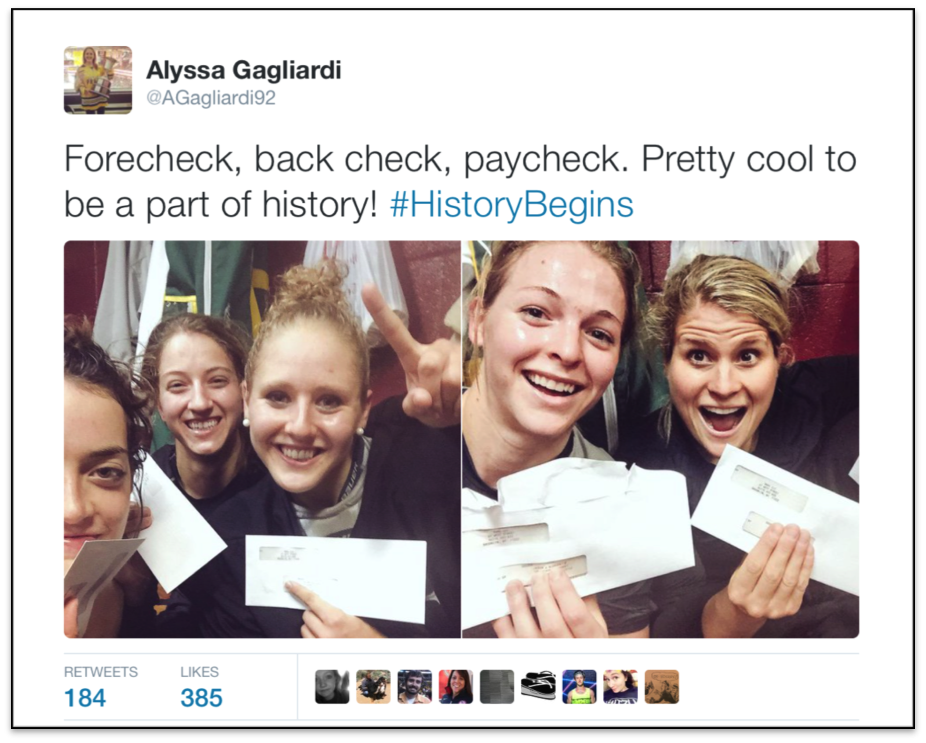What We’re Worth
When I was eight years old, I had to create a timeline poster for a class project. I don’t remember the exact assignment, but looking back, it seems as though I had to highlight some important events throughout my young life; you know, casual things like being born, moving to a new city, starting to play hockey. One event even marked the year that I “met NHL players” Jaromir Jagr and Mario Lemieux. (Kind of a big deal).
young life; you know, casual things like being born, moving to a new city, starting to play hockey. One event even marked the year that I “met NHL players” Jaromir Jagr and Mario Lemieux. (Kind of a big deal).
Now, flash forward 16 years, I’m sitting in a room at Harvard’s Bright-Landry Rink getting asked the question:
“So, what do you think? Should women make as much money playing sports as men?”
My teammates and I have all been asked this more times than we can count. Sometimes we laugh a little at how silly that question seems. Of course we wish we were paid as much as guys that play professional sports. I’d love to be able to throw around the flying money emoji all the time.
C’mon. You know which one I’m talking about…![]()
In pretty historical news last week, professional softball player, Monica Abbott, signed a contract that will pay her $1 million dollars over the next six seasons in the National Pro Fastpitch league. (![]() )
)
Unfortunately, that’s so far from the norm for professional female athletes. The league I play in – the National Women’s Hockey League (NWHL) — has a team salary cap of $270,000. In other words, our entire team’s salary could easily be covered by one 4th liner’s salary in the NHL. Looking at the NHL salary rankings, it appears the lowest salary cap hit is around $500,000.
But hey, we’re getting paid to play, right?! Well, yeah. Women getting paid to play hockey is something really novel still and something that hadn’t been available until last year when the NWHL began its inaugural season. It was always hard to call ourselves professionals when we competed at the highest levels; playing and training competitively every day, yet making no money.
Even in college, it was the mindset that if you wanted to make a little money playing hockey, then pack your bags and head to Europe for a year or two. Otherwise, you could play in the US or Canada, but you wouldn’t make money. With national team aspirations and wanting to gain some work experience, the European leagues didn’t appeal to me.
This might sound strange, but it actually felt weird signing my first contract last year.
In the two years since graduating from Cornell University in 2014, I have had the unique opportunity to play in two women’s professional leagues. In one league, we had no salary. In the other, our salary is equivalent to a part-time job, where the league maximum comes in right around $26k (remember that 4th liners salary of $500k?!). Both leagues are pushing each other to be better and to create stronger opportunities for women playing hockey at the highest level.
So, you can imagine when I went to meet our team’s GM last year to sign my contract that it felt weird. It felt as if I was crossing over into some foreign enemy territory where confidently saying “pay us to play” was seen as asking far too much. As female hockey players, it has been ingrained in our minds that we just play hockey after college for the love of the game, not for any monetary value. It was hard to view our skillsets and talents as worth much.
When the NWHL began last year with four teams, 80+ players decided to give it a shot. The general consensus of thinking was: if we don’t take this opportunity to get paid to play now, we may never get the opportunity again. It was the very first year of the league, so there were plenty of risks involved and plenty of ups and downs throughout the six-month season, but the payments always came through.
After one of our pre-season practices, we were handed envelopes containing our first ever paychecks. I think we all took a second to realize the significance of what was in those envelopes. It wasn’t a million dollars by any means, but it was something. Our skills, time, and effort were being valued. It was a special moment, and I was lucky to share it with an amazing group of teammates and coaches.
“I think we all took a second to realize the significance of what was in those envelopes.”
We even had a little fun marking the history  being made. (And it helped my Twitter game improve significantly).
being made. (And it helped my Twitter game improve significantly).
As a generation and as players competing at the highest level, we have decided that it’s no longer enough to be grateful to just have a place to play, or to simply play for the love of the game.
We can sit here all day and preach that it’s about growing the game, because to a major extent, it is. We want little girls to pick up a stick and fall in love with the game of hockey like we did when we were growing up.
But, we also want them to pick up their sticks and say “I want to be a professional hockey player” and not have the illusion that the NHL is the only way to do that.
After signing her historic contract, Abbott said, “I see opportunities for other athletes, for the college girls coming in [to the league], for the college freshmen, for the 12-year-olds. I see opportunities for them to only be a professional softball player. To not have to have another career, another job.”
It might take awhile, but we’re hoping to do the same.
And when little girls are assigned a poster project to mark important life events, maybe meeting some professional women’s hockey players will make the cut.